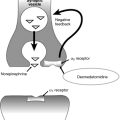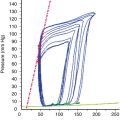Fluid management in infants
Maintenance fluids
Reliance on the method of Holliday and Segar continues despite concern regarding its relevance to the perioperative care of young children. In their seminal 1957 paper, the authors provided a simplified method for estimating maintenance fluids and electrolytes based on energy requirements: 1-kg to 10-kg infants need about 100 cal·kg−1·24 h−1; each kilogram over 10 kg and up to 20 kg requires an additional 50 cal·kg−1·24 h−1; after 20 kg, each additional kilogram requires 20 cal·kg−1·24 h−1. Approximately 1 mL of water is needed for each calorie expended. This method can be simplified (Table 194-1). These recommendations were intended to guide maintainence fluid therapy for hospitalized children, however, and not for intraoperative care.
Table 194-1
Maintenance Fluid Therapy for Hospitalized Neonates and Infants*
| Weight (kg) | Fluid Needed (mL • kg−1 • h−1) |
| < 10 | 4 |
| 10-20 | 2 |
| > 20 | 1 |
Note: These recommendations are NOT intended to be used intraoperatively.
Fluid replacement
The fluid deficit in a patient receiving nothing by mouth can be calculated by multiplying the number of hours that the patient is not receiving anything by mouth by the maintenance fluid requirement. Although a scientific basis for the following recommendation is lacking, common practice is to not only provide maintenance requirements, but also replace half of the fluid deficit in 1 h, one fourth of the deficit in the second hour, and the final one fourth of the deficit in the third hour. Likewise, limited data exist to support the practice of replacing third-space losses, as has been described in most standard texts of pediatric anesthesia (Table 194-2). Many factors may influence fluid requirements in the very young, making the use of simplified formulas problematic and potentially dangerous. In the neonate, insensible water loss is increased by fever, crying, sweating, hyperventilation, bilirubin lights, and radiant heaters. Adequacy of fluid therapy is best monitored by clinical signs (heart rate, blood pressure, urine output, capillary refill, central venous pressure) rather than by blind adherence to a poorly validated formula. A few simple rules that will help to avoid problems occasionaly encountered in fluid management:
Table 194-2
Guidelines for Third-Space Fluid Replacement
| Probability of Fluid Translocation | Example Procedure | Additional Fluid Replacement (mL • kg−1 • h−1) |
| Little or no | Craniotomy | 0 |
| Mild | Inguinal hernia | 2 |
| Moderate | Thoracotomy | 4 |
| Severe | Bowel obstruction | 6 |
• Intravenously administered hypotonic fluids should, in general, not be used in the operating room. Hyponatremia in the perioperative setting is a concern and has been associated with many deaths. However, replacement of sodium should rarely be undertaken in the operating room. Alterations in serum sodium are more often a reflection of abnormalities in total body water than in sodium, and, more importantly, rapid replacement of sodium can result in devastating neurologic injury.
• Metabolic acidosis is most often a reflection of poor tissue perfusion and should first prompt the anesthesia provider to evaluate the patient’s volume status. If a decision has been made to treat metabolic acidosis, give one half of the ![]() calculated requirement, and then reassess the acid-base status: calculated
calculated requirement, and then reassess the acid-base status: calculated ![]() (mEq) = base deficit × weight (kg) × 0.3 (0.4 for infants).
(mEq) = base deficit × weight (kg) × 0.3 (0.4 for infants).
• Potassium replacement is rarely indicated in young children and carries significant risk. If undertaken, replacement should be accomplished slowly, with frequent monitoring of serum potassium concentration. Replace at a maximum of 3 mEq·kg−1·24 h−1 at a rate not to exceed 0.5 mEq·kg−1·h−1. Ideally, urine output should be maintained at 0.5 to 1.0 mL·kg−1·h−1.
• Hypocalcemia is a frequent complication of massive transfusion (Table 194-3). Tissue loss from extravasation of calcium chloride given through a peripheral intravenous line is an unfortunate occurrence that can be avoided by employing central venous access or through the use of calcium gluconate. The typical dose of calcium chloride is up to 10 mg/kg and, for calcium gluconate, 30 mg/kg.
Table 194-3
Mechanisms of Complications of Massive Transfusion
| Complication | Mechanism |
| Acidosis | Poor O2 delivery, lactate accumulation |
| Alkalosis | Citrate metabolism to bicarbonate by the liver |
| Hypocalcemia | Citrate binding of calcium |
| Hyperglycemia | Dextrose preservative in packed red blood cells |
| Hypothermia | Transfusion of cold blood products |
| Hyperkalemia | Multifactorial |
Blood replacement
In 1996, the American Society of Anesthesiologists Task Force on Blood Component Therapy published transfusion practice guidelines that are probably applicable to pediatric patients without cardiopulmonary disease. The points regarding red blood cell transfusions are summarized here. Guidelines specific to pediatric patients older than 4 months of age have been published (Box 194-1).
• Transfusion is rarely indicated when hemoglobin concentration is above 10 g/L and is almost always indicated when the hemoglobin concentration is less than 6 g/L, especially if the anemia is acute.
• The determination of whether intermediate hemoglobin concentrations (6-10 g/L) justify transfusion should be based on the patient’s risk for developing complications related to inadequate oxygenation.
• The use of a single hemoglobin trigger for all patients is not recommended.
A number of calculations have been presented for the evaluation of transfusion thresholds. One such formula proposes that the maximum allowable blood loss should equal the estimated blood volume multiplied by the hematocrit minus the target hematocrit divided by the hematocrit. In clinical practice, these calculations have limited utility as they are dependent on estimates of blood loss that have been repeatedly shown to be inaccurate. In children, transfusion is best guided by close monitoring of hemodynamic parameters and frequent determination of hemoglobin concentration. Estimated blood volume for various ages is shown in Table 194-4.
Table 194-4
Estimated Blood Volume in Infants and Children
| Age Group | Estimated Blood Volume (mL/kg) |
| Premature infants | 90-100 |
| Term newborns | 80-90 |
| Infants younger than 1 year | 75-80 |
| Older children | 70-75 |






